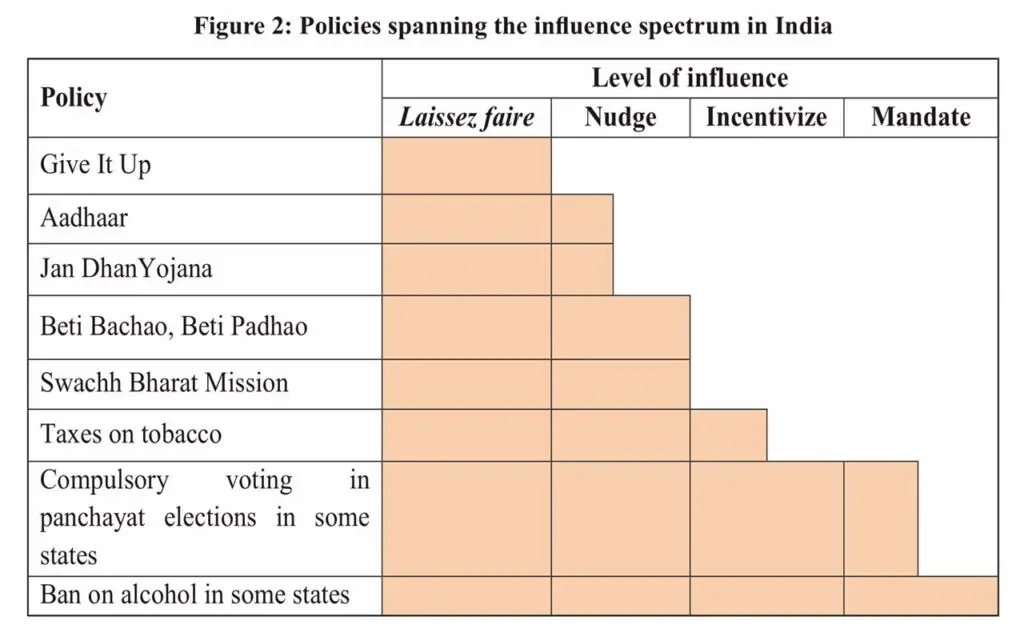Social Influence and Persuasion
Persuasion is a symbolic process wherein communicators aim to influence others by transmitting messages to alter their attitudes or behaviors. It represents a form of social influence, blending social thinking and everyday life.
The behind closed door / ‘Darwaza Band’ Campaign to prevent open defecation is a good example of using social influence to bring attitudinal change.

The key elements of persuasion are as follows:
- Persuasion employs symbols such as words, images, and sounds to convey messages.
- It involves a deliberate effort to sway others’ perspectives.
- Self-persuasion is essential, as individuals are not coerced but rather free to make their choices. Coercive techniques lack scientific evidence of effectiveness.
- Persuasive messages can be transmitted through various channels, including verbal and nonverbal means like television, radio, Internet, or face-to-face communication.
The impact of persuasive communications on attitudes is significant. We encounter numerous advertisements daily through television, radio, and the Internet, facilitating the rapid spread of persuasive messages.
Nonetheless, the success of persuasion relies on three factors:
- The source of the message.
- The content of the message.
- The nature of the target audience.
Persuaders seek to influence our beliefs and attitudes, influencing us to vote for them, purchase their products, render favors, or comply with their desires. Advertisements serve as the most common form of persuasion.
What does the term “Social Influence” mean?
Social influence encompasses the process through which individuals encounter persuasive communication, leading to the acquisition and modification of their attitudes, beliefs, intentions, and behaviors.
This phenomenon becomes more prominent when people form their beliefs based on the opinions of others rather than independent reasoning.
Factors that shape and impact social influence.
- Reciprocity: People tend to comply with requests from those who have fulfilled their demands recently. The sense of obligation to reciprocate favors also plays a significant role in decision-making, activating feelings of guilt when someone fails to reciprocate as expected. This can lead to a cycle of reciprocal altruism where people continue doing favors for each other.
- Physical attractiveness: Research indicates that physically attractive individuals are often more persuasive than others, even if they don’t appear more intelligent or competent. Attractive people are more likely to be believed, rewarded, and liked compared to their less attractive counterparts. The color red, for instance, can be associated with love or romance, leading to unconscious associations with attractiveness and desire.
- Dominance: Dominant individuals may use coercive power and threats rather than logic to persuade others.
- Scarcity: When an item is perceived as scarce, people tend to desire it more than when it is perceived as plentiful. This concept of scarcity influences decision-making and can lead to increased desirability for scarce items.
Three Domains of social influence.
- Compliance: Compliance involves agreeing to fulfill a request or demand made by another person. When individuals comply, they carry out the requested action, often motivated by a wish to avoid punishment or to receive some form of reward. For instance, compliance may stem from a fear of negative consequences or a desire to gain approval from others.
- Conformity: When individuals conform, they adjust their behavior to align with the norms and expectations of a specific group or situation. This can be driven by a desire to fit in or a belief that following the group’s lead is the morally right thing to do.
- Obedience: Obedience refers to performing an action in response to an order issued by a person in a position of authority, such as a police officer. The act of obedience is usually influenced by the authority figure’s power and the conviction that following their command is essential.
Here are some related article (Give a Quick reading)
The concept of gender is a product of social construction.

Persuasion
Persuasion is a significant form of social impact, involving the act of convincing individuals to adopt a particular viewpoint or take a specific action. There are diverse methods of employing persuasion, all aimed at achieving the common goal of gaining agreement from others.
The process of persuasion involves three key elements: the sender, who delivers the message; the recipient, who is being convinced; and the circumstance or environment in which the messages are conveyed. Each of these factors plays a crucial role in shaping the effectiveness of persuasive messaging.
Fantastic example of Persuasion – P Srinivas, Indian Forest Service

The process of persuasion unfolds in three distinct stages.
The initial stage is known as pre-suasive conditioning, where a person is exposed repeatedly to a message over time, gradually becoming accustomed to it and accepting it as a normal part of their environment.
The second stage is termed the central route to persuasion. During this stage, individuals carefully assess the arguments presented to them and make decisions based on logic and reason, weighing the merits of the message before accepting or rejecting it.
Finally, the third stage is referred to as the peripheral route to persuasion. In this stage, individuals may focus only on specific aspects of the argument, sometimes even fixating on a single word within a sentence, and consequently accept the message without thorough consideration.
Persuasion Theories:
Robert Cialdini’s influential persuasion theory revolves around six principles that influence human behavior.
1.Reciprocity is based on the notion of repaying favors we receive from others. When someone gives us a gift, we feel a sense of obligation to return the favor, creating a cycle of reciprocity.
2.Commitment and consistency are about our desire to align with our past actions. Once we commit to something, like starting a diet, it becomes challenging to backtrack on that decision. Exploiting this principle, others can use previous agreements to persuade us further.
3.Social Proof relies on people looking to others for behavioral cues. For instance, when deciding what to wear at a party, one might observe what others are wearing to fit in appropriately.
4.Authority figures leverage their credibility to persuade audiences. Companies often seek endorsements from famous individuals, assuming that their positive association will influence consumers’ decisions.
5.Liking occurs when people are more likely to comply with requests from individuals or companies they have positive feelings towards. Celebrities endorsing products can capitalize on their likability, but it’s important to note that not all endorsements are financially motivated.
6.Scarcity works on the principle that people desire things less once they become widely available. Limited-edition items and exclusive deals are tactics companies use to create a sense of urgency and make their products more enticing to potential customers.
Impact of Persuasion:
The impact of persuasion can manifest in various ways, influencing people’s thoughts, emotions, and behaviors. It has the power to shape beliefs and decision-making processes. Moreover, persuasion can result in increased compliance and obedience to certain requests. It has the ability to transform an individual’s attitude, generating a renewed sense of self-esteem or a newfound motivation for action, as exemplified by the influence of a compelling public speaker (source).
Two main types of persuasion exist:
- Heuristic Persuasion: In contrast, heuristic persuasion utilizes emotional appeals to sway someone’s opinion. It plays on the audience’s emotions and instincts, like an advertisement for a horror movie that aims to evoke fear or excitement in potential viewers.
- Systematic Persuasion: This approach relies on logic, reasoning, and factual evidence to persuade someone. It involves presenting a well-structured argument to appeal to the audience’s intellect, such as offering logical reasons for supporting a political party during an election.
Elements of Persuasion:
The Impact of Social Influence on Persuasion:
Social influence plays a significant role in the process of persuasion, affecting an individual’s attitudes, beliefs, and actions through interactions with others. Persuasion involves one person attempting to change the viewpoint or behavior of another person, employing various strategies like offering rewards or making threats to achieve their objective.
Distinguishing Persuasion from Social Influence:
While persuasion is a unilateral process wherein one person endeavors to convince another to alter their attitude or conduct, social influence is a reciprocal exchange where both parties attempt to sway each other’s viewpoints. For instance, when two friends discuss whether one should end their current relationship, they engage in social influence by using reasoning and emotions to influence the decision. Disagreements may arise in this process, leading to differing opinions on whether to stay in the relationship or not. In cases where there are no disagreements and unanimity prevails, it qualifies as persuasion, as there are no conflicting viewpoints among the involved individuals.
Mains Question GS4
Q. How could social influence and persuasion contribute to the success of Swachh Bharat Abhiyan? (150 words) 10 marks. Q 4(b)
Examples of Public Policies that are driven by the need to bring behavioural change and attitudinal change.

in the context of bringing attitudinal change through social norms, persuasion, awareness, communication (here is the article to help you to think about this).

Essay Topic
“Patriarchy is the least noticed yet the most significant structure of social inequality” 1000-1200 words. (2020 UPSC Mains Question Paper)
The below is very relevant in this regard.

